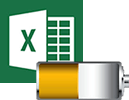Level 2 (Intermediate) Excel Course
This course will upgrade your scrappy, self-taught Excel skills so you can design spreadsheets better, faster and smarter?

Course Description
This 1 day intermediate Excel course is designed to improve your productivity within Excel.
You'll discover the most useful and most commonly used parts of Excel - the features that can be used by anybody in any type of business.
You'll master techniques to achieve quick results and produce slicker, more efficient workbooks that are better laid out, more consistent and easier to maintain.
Want To Customise Your Content?
Don't see exactly what you want in the topic list below?
You are welcome to swap topics in and out from the different courses available to create your own custom course.
We can accommodate all requests. Customisation is 100% free.
Let us deliver a powerful course with useful content that you or your staff will actually use. Tailor the training around your own needs and requirements.
Duration
Corporate group training: 1 day.
Private 1-on-1 training: 3-4 hours.
Prerequisites
This course is designed for people who have used Excel regularly for a minimum of 45 days. Please view the contents of the beginners Excel course and make sure that you are comfortable with 80% of the contents before considering this course.
Versions Taught
Our computers are always installed with the latest version of Office. The current version is Excel 365 (desktop).
If you have an earlier or Excel such as Excel 2016 or Excel 2013 we will explain any key differences during the training.
Still using Excel 2010 or earlier? It's time to say goodbye to an old friend and upgrade! Microsoft don't support this version any more.
